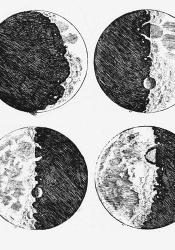The Moon's Surface
After making vast improvments in the telescope in 1609, Galileo was able to make detailed observations of various planets as well as the moon. One such observation was that the moon was not the perfect spherical surface society assumed it to be, but rather was made up of various valleys, plains, and moutains much like the Earth's surface. This gave further insight into da Vinci's observations on the various dark spots scattered throughout the moon's surface. These discoveries were particularly radical since the moon, like the planets, were through to be perfect celestial beings and the thought of them containing imperfections would have been highly controversial.

